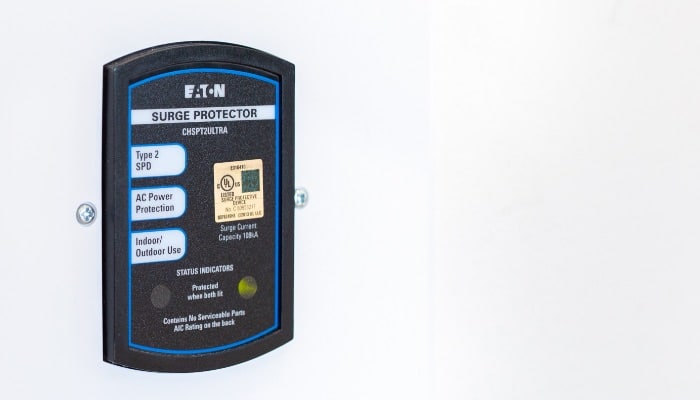
When heavy storms hit Alpharetta and the Atlanta metro area they bring major lightening strikes. These storms are deadly to the expensive electronic equipment that is so common in today’s homes. Growing up, you may have heard “unplug the TV, it looks like its going to storm!” Well, now there is a better and more sure proof way of protecting your home during a storm without unplugging every device you have – Whole House Surge Protectors.
Whole house surge protectors protect every appliance and electronic device in your home from damaging electrical surges. Electrical surges are spikes in the electrical voltage coming into your home. These spikes are generally caused by your power provider, electrical problems inside your home, or lightening strikes.
How do surge protectors work?
Surge protectors work by monitoring the flow of electricity through your house. When the voltage goes up, the surge protector drains the excess voltage into the ground and away from your sensitive electronics. If you own a digital microwave, flat screen TV, A/C unit, or similar appliance, invest in a whole house surge protector. Even small surges coming from your local power company damage electronics and reduce the life of your equipment. Whole house surge protection is inexpensive and protects the most expensive items in your home.
What is a surge protector and what does it do?
The surge protectors that we supply are installed in the main electrical panel box, the heart of your home’s electrical system. They are designed to stop lightning or power surges at the panel, before they enter the rest of your home, unlike the point of use surge protectors that stop a surge after it is already in your house (and next to your walls, furniture, carpet drapes, and other flammables)!
The panel surge protector diverts all of the energy away from your home and out into your home’s grounding system. You will want to make sure you have a good grounding system (our electrician can inspect the grounding system while he is there installing the surge protector). Additionally, surge protectors “clean up” the minor fluctuations in energy that occur throughout the day. While these small spikes in power may go unnoticed by you, over time they can wear down and reduce the lifetime of more sensitive electronics.
Will a surge protector help me save money on my power bill?
No. A surge protector is simply a gatekeeper, not an energy-saving device. The power coming to your surge protector will have already passed through your meter and be recorded to your account with your electrical service provider. The surge protector is designed only to block surges in energy.
Will a surge protector in the panel box protect everything in my home?
Yes, however, there are several ways lightning can enter your home. The most common way is to travel along the main electrical, cable, or phone lines after a strike. Lightning commonly takes the path of least resistance to quickly exhaust all of its energy. While lightning is extremely powerful, it is also pretty lazy, and its preferential path is an unobstructed one. A whole-house surge protector will protect your entire home once the voltage increase reaches the electrical panel, but will not be able to prevent lightning damage on circuits the lightning hit before reaching the panel. This is why secondary "point of use" surge strips and plugs are very important to a comprehensive protection plan.
Should I keep my current plugin surge protectors?
Yes, we recommend that you use any “point of use” surge protectors or “power strips” that you already have behind your TV, computer, or other sensitive equipment, as added protection! Lightning can still strike the gutter or roof line, for example, and then “jump” to a nearby cable and travel through your home that way, bypassing the surge protector altogether. In an instance like this, the point of use surge protector that your equipment is plugged into would block the surge.
How big is a surge protector?
The main panel surge protector is about the size of two decks of cards. The cable and phone surge protectors are smaller.
Where does a surge protector go?
Whole house surge protectors are installed at the main electrical panel or meter in your home.
What if I have more than one electrical panel?
If you have more than one panel you may or may not need two surge protectors. It depends on how your panels are fed from the meter. The electrician can look at it and let you know.
Is there a warranty on the surge protector?
Yes, there is a warranty offered by the manufacturer including a limited warranty for damage to connected equipment (appliances, furnaces, well pumps, etc.). These are generally up $25,000 - $75,000 per occurrence. Please check the warranty information on your unit for exact details. We encourage customers to look at the warranty when buying surge protection. However, the most important thing is that you have surge protection. The worst call we get is from a customer who didn’t get a surge protector installed, for whatever reason, and now has extensive damage and costs to worry about.
Is my flat-screen TV covered by the warranty?
Televisions are protected by the whole house panel surge protector connected equipment warranty if a point of use surge protector is installed at the plug and have all the television components (cable, power, etc.) running through the point of use surge protector at the time of the incident. This is a warranty requirement found in the fine print of most surge protector manufacturers instructions. Install secondary surge protection on your sensitive electronics and equipment.
How does Cable Surge Protection work?
The cable surge protector is very similar in function to the panel surge protector. It is installed in your cable box, which is usually found mounted on a wall outside your home. It works the same way as the panel surge protector does by stopping excess energy right at the source, before it enters your home, and diverting it out into your grounding system. If you have cable television or Internet service, you want to have a cable surge protector because a lightning surge can travel along your cable line and into your computers, televisions, DVR, DVD players, and any other connected equipment. You also want to be sure that you have an adequate and properly installed grounding system and that your cable system is connected to it.
How does Phone Surge Protection work?
The phone surge protector is also very similar in function to the panel surge protector. It is installed in your phone box, which is usually found mounted on a wall outside your home. It works the same way as the panel surge protector by stopping the energy right at the source before it enters your house. If you have a home phone line and/or are using a phone line for your Internet, you want to have a phone surge protector installed because a lightning surge can travel along your phone line and into your computers, corded phones, and cordless phone bases, answering machines and any other connected equipment. You also want to be sure that you have an adequate and properly installed grounding system and that your phone system is connected to it.









